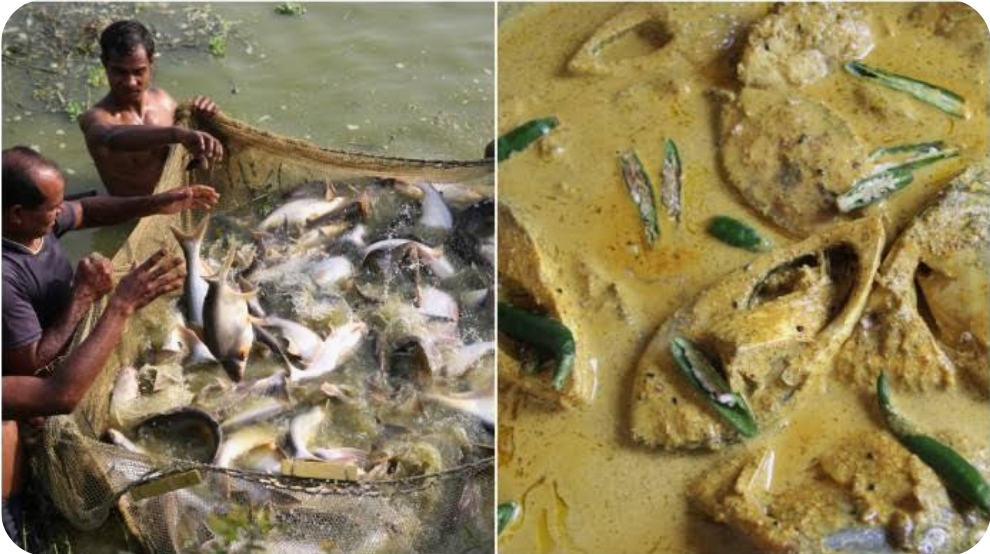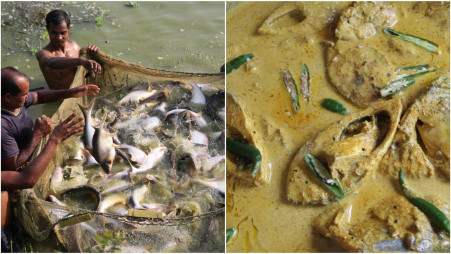What the ‘fish paradox’ tells us about fish eating habits in Bangladesh


Sharmin Akhtar, a mother of two under the age of 10, stood in front of the cash counter at a supershop in Moghbazar. She had purchased an 800 gram special package of “Haorer Panch Mishali Maach”, among other things, but was now contemplating whether to also buy some chicken or beef.
“I am not sure if my children will want to eat the fish curry. No matter how hard I try, they often refuse to take a single bite of fish,” she shared in a rather disappointing tone.
“As the kids don’t want to eat fish, I always need to have a meat option available for them,” she added.
Sharmin is certainly not alone in facing challenges with her children’s reluctance to eat fish. Almost all the parents of children and young adults we spoke to shared similar experiences.
Meherin Tripti, aged 16, shared her reason for not liking fish: “Because I can’t stand the smell of fish, which is… fishy.”
She also expressed her dislike for fish bones, citing several childhood memories of them getting stuck in her throat. “I don’t want to take any further risk,” she stated.
Needless to say, most of the young people we spoke to also spoke along the same line, with some mentioning that their parents found serving meat items more convenient during their childhood, which led to them not developing fish-eating habits.
Interestingly though, existing data don’t really reflect the decline in eating fish among the younger generation of the country, as “there hasn’t been any fish eating survey or study focussed on any specific age group,” said Dr Badrun Nessa Ahmed, who has been conducting research on fish, food value and nutrition for the last few years.
Instead, the Household Income and Expenditure Survey 2022 conducted by the Bangladesh Bureau of Statistics indicates that Bangladeshis are consuming slightly more fish than before. In 2016, the daily per capita consumption of fish was recorded at 62.6 grams, which increased to 67.8 grams in 2022.
Also, another study from 2017 suggests that people in Bangladesh were eating 30% more fish than they did 20 years ago.
“Many middle and lower-middle class people are now being forced to turn to fish as their main source of protein, as even the price of broiler chicken is out of many people’s reach,” commented Dr Ahmed, also a Senior Research Fellow at Bangladesh Institute of Development Studies.
But another paradox is, “even though the overall fish consumption has increased over the past few decades, it does not necessarily translate into obtaining more essential nutrients from fish,” she added.
Indeed, several studies suggest that the amount of important nutrients derived from fish is dwindling in the country. As a result, more than 20 million Bangladeshi women and children are malnourished, either suffering from anaemia (women) or stunting (children and adolescents).
Hence, the trend of fish consumption in Bangladesh raises a twofold question: why are Bangladeshi young people losing interest in eating fish, and why is the overall increase in fish consumption failing to ensure a population that is fully nourished and healthy?
Consultations with experts in this regard revealed that improvising the traditional fish cooking methods could be a solution to pique the interest of young people in fish consumption.
However, it’s also crucial to note that while the quantity of fish consumed in Bangladesh has increased, the nutritional quality has decreased due to a shift from nutrient-rich small indigenous fish to less nutritious farmed fish.
Why the younger generation don’t want to eat fish
According to experts, the reason behind the younger generation losing interest in eating fish falls squarely on their parents.
“Especially among the city dwellers, parents nowadays are not interested in fish cleaning and cooking, as many of them are service holders,” said Dr Md Abdul Wahab, Professor of Marine Fisheries and Aquaculture at BSMR Maritime University.
He also mentioned bones as an important issue that discourages the younger generation from eating fish; while parents also do not help remove the bones and assist the children with eating fish.
WorldFish, an international, non-profit research and innovation organisation reducing hunger, malnutrition and poverty across Africa, Asia and the Pacific, also acknowledged this trend among Bangladeshi parents.
It identified that a change in the cooking method of fish might be helpful for the younger generation, and recently organised fish cooking demonstrations in several villages in the Rajshahi and Rangpur districts.
It showed how indigenous small fish like mola, dhela and darkina, including their head and eyes, can be mashed before adding them to khichuri. This ensures that the dish is delicious while also minimising the risk of fish bones getting stuck in children’s throats.
Dr Ahmed further explained from her research findings that the younger generation can be enticed into eating fish, “provided the preparation is unique.”
According to her, the traditional way of cooking fish in Bangladesh doesn’t appeal to the younger generation because “their taste buds are different.”
“Teenagers don’t enjoy the typical curry or fried preparation of raw fish. However, if fish is served in different ways, such as making fish balls or mixing fish powder with soup, they are much more likely to enjoy those dishes,” she explained.
Why a surge in fish consumption is not enough
Despite the overall increase in fish consumption in Bangladesh, which corresponds with the increased production of fish in aquaculture, the primary reason behind malnutrition among children and women is the lack of availability and affordability of fish that are actually beneficial for health.
In the fiscal year 2022-23, the total production of fish was 49.15 lakh MT, which is a remarkable increase of 82% over the past 15 years. Overall, Bangladesh stands as a global leader, ranking third in fish extraction from open water bodies and fifth in aquaculture production. By 2041, the country also aims to produce 85 lakh mt of fish.
However, “the poorer section of our population cannot afford to buy good fish. They mostly rely on small Silver Carp, small size Pangas, and low quality Tilapia. These fishes lack essential micronutrients like calcium, zinc, iron, vitamins A, vitamin B12 as well as high-quality protein,” said Dr Wahab, also a retired Professor of Fisheries Management at Bangladesh Agriculture University.
On the other hand, the main sources of essential micronutrients are small fish with soft bones, such as mola, dhela, darkina, and chela. However, these types of fish are not widely available in most areas of the country except in haors and large beel areas.
“The price of these small indigenous fish species are also very high and not affordable for the poor rural and urban poor communities,” Dr Wahab added.
He also pointed out that due to the degradation of many rivers, connected beels, and low-lying areas in the greater Khulna and parts of the Rajshahi regions, the natural abundance of fish with high nutrient content is no longer available.
Meanwhile, Dr Ahmed explained the difference between “capture fish” (caught from the wild) and “culture fish” (fish farmed under controlled conditions).
Notably, aquaculture, or fish farming, has been rapidly expanding since its introduction in Bangladesh in the 1980s.
Dr Ahmed described that although there has been a “blue revolution” in the country due to the rise of aquaculture, resulting in increased production and consumption of fish, it is not effectively addressing people’s nutritional needs.
This owes to the fact that aquaculture is dominated by a handful of large fish species, both indigenous and exotic. Only the flesh of these large fish is normally eaten, which, while a rich source of high-quality protein, generally has lower micronutrient content.
Hence, Dr Ahmed believes that just because people in general are consuming more fish it’s not necessarily positive news. It’s also important to ensure that small indigenous fish are accessible to everyone. Currently there are around 300 species of small indigenous fish available in Bangladesh.
Furthermore, the way these fish are prepared and cooked can also impact their nutritional value.
For example, many people in Bangladesh tend to deep fry the fish before cooking. While this method aligns with the flavour preferences of Bangladeshi people, it may result in a loss of nutrients and an increase in fat content and cholesterol levels.
“If the preparation or cooking method is not improved, neither can proper nutritional value be derived, nor will the younger generation be interested in consuming them,” she concluded.





